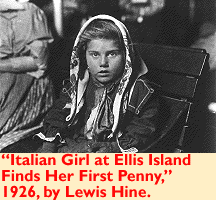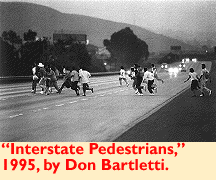OVER AT THE Center for Creative Photography, there's a story about me and a story about you...a story, in fact, about every single person in this Nation of Strangers.
 The tale of how we came to live where we do and how we came to
be who we are is told in a new show that offers a highly politicized--and
highly critical--history of immigration to the United States.
Through more than 200 photographs, political cartoons, broadsides
and engravings, the exhibition chronicles the long emigrant saga
that began centuries ago with the arrival of the colonial conquerors
of the "New World" and continues to unfold to this day
on makeshift Haitian and Cuban rafts and along the porous border
between the U.S. and Mexico.
The tale of how we came to live where we do and how we came to
be who we are is told in a new show that offers a highly politicized--and
highly critical--history of immigration to the United States.
Through more than 200 photographs, political cartoons, broadsides
and engravings, the exhibition chronicles the long emigrant saga
that began centuries ago with the arrival of the colonial conquerors
of the "New World" and continues to unfold to this day
on makeshift Haitian and Cuban rafts and along the porous border
between the U.S. and Mexico.
A Nation of Strangers, co-curated by Arthur Ollman, director of the Museum of Photographic Arts in San Diego, and Vicki Goldberg, an art critic for The New York Times, is Part Two of a three-show series on immigration running all season at the Center for Creative Photography. Like the first show, which gave us a wry view of America through the lenses of immigrant photographers, the new one takes exception to standard American rhetoric about a harmoniously flavored melting pot. But here the line of vision is different: These are pictures produced by and large by American insiders looking out at the newcomers. Among the earliest images is a drawing of a slave ship, its African kidnap victims efficiently chained in every available cranny. A newspaper drawing of captives on an illegal slave ship of the mid-19th century takes a genial view of the "colorful" natives huddled naked on deck.
America, the curators insist in an opinionated wall text, has rarely welcomed its new arrivals. Worse, the nation exploits each successive wave of poverty-stricken immigrants, using their desperation to keep wages low for immigrants and natives alike. The typical result is an unproductive clash between the two groups.
An 1850 broadside, for instance, tries to incite workers against the desperate Irish pushed to America by the great potato blights and murderous English policies of the 1840s. "Natives of the Soil! Arouse!" it screams in big black capital letters. "Shall American Labor be Protected Against Foreign Competition in the Home Labor Market?" It invites natives to a meeting to discuss the "ruinous influence of foreign immigration on American Labor."
But as the curators note, the workers' rage was misdirected. Politicians and capitalists with an interest in keeping wages low have long been adept at manipulating public sentiment against immigrants. (Not much has changed today.) As the Irish came to learn, the same game could be played against them. In 1870, Irish immigrant shoemakers in Massachusetts formed a union and went on strike. The factory owners brought in Chinese workers whose own precarious position in America led them to work for even lower pay. The strike was broken. A grainy 1875 photo shows Chinese workers lined up in front of the shoe factory, apparently now permanently installed.
 While economics is the linchpin of anti-immigration rhetoric,
racism and fear of the other have always played a part. As early
as 1654, Peter Stuyvesant tried to keep Jewish emigrants out of
New Amsterdam, the curators tell us. The anti-Irish poster of
1850 also rages against the "alarming increase of popery,"
a nasty name for Catholicism. A fine black-and-white photograph
by the landmark photographer Eadweard J. Muybridge of a Chinese
laborer is titled "The 'Heathen Chinee' with Pick and Rocker."
While economics is the linchpin of anti-immigration rhetoric,
racism and fear of the other have always played a part. As early
as 1654, Peter Stuyvesant tried to keep Jewish emigrants out of
New Amsterdam, the curators tell us. The anti-Irish poster of
1850 also rages against the "alarming increase of popery,"
a nasty name for Catholicism. A fine black-and-white photograph
by the landmark photographer Eadweard J. Muybridge of a Chinese
laborer is titled "The 'Heathen Chinee' with Pick and Rocker."
This show has a social documentary rather than an art focus, particularly since photography didn't become widespread until after the 1840s. But by the turn of the century, photojournalism had come into its own. Artistically inclined photographers recorded the faces of the masses passing through Ellis Island and taking up residence in the worst corners of American cities. Included are the famous pictures of immigrant children by Lewis Hine, a crusader whose poignant works helped get child labor laws changed, and the searing images of tenement life by Jacob A. Riis. There's even an uncharacteristic still life by Ansel Adams, an evocative view of the all-American possessions of a Japanese-American in a World War II "relocation" camp. Scattered on a table is a snapshot of the family's son in his U.S. Army uniform and a holy card of the Christian Lord.
If many of these older pieces can now be safely glossed over in American history, winning the homage of descendants who romanticize their immigrant past, the new pictures in the final third of the show cannot. These difficult pictures have all the emotional impact of today's headlines and today's vicious campaigns against immigrants. Skilled photojournalist Don Bartletti has been documenting the "undocumented" of the contemporary Southwest. One photo taken earlier this year, "Interstate Pedestrians," shows Latinos racing across a dangerously crowded highway, risking all to get into America. In his 1989 "Highway Camp," Central American workers sleep under rough blankets on a hill along the roadway. And inevitably there are the shots of flag-waving American citizens demonstrating against these newest immigrants to America's shores, here to do American's dirtiest work, at the lowest possible wages, and to earn in return America's scorn.
A Nation of Strangers is a huge show that radiates a justifiable rage. But the images the curators have been able to assemble don't always have the power of their words: A couple of studio portraits of plump matrons, for instance, illustrate a discussion of chronic anti-Jewish feeling in America. We have to take the curators' word for it. And there are a couple of factual missteps: True, the Irish did enlist in the Army in the Civil War, but they were also selectively and disproportionately targeted by draft boards. And it was not always the case that a command of English helped the Irish assimilate more readily: The Famine Irish were largely Irish speakers, country peasants who represented the last of traditional Irish culture.
These quibbles aside, this is a powerful show with a lot to teach us. And its strong historical bent does much to illuminate the current, racist tirades against the newest strangers to join the nation.





